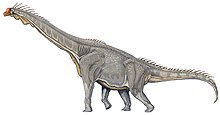Pelvis dinosaur
| Pelvis dinosaur | ||||||||||||
|---|---|---|---|---|---|---|---|---|---|---|---|---|

The basal lizard dinosaur Eoraptor |
||||||||||||
| Temporal occurrence | ||||||||||||
|
Carnian ( Upper Triassic ) to Upper Cretaceous (birds to the present ) |
||||||||||||
| 228 to 65.5 (or 0) million years | ||||||||||||
| Locations | ||||||||||||
|
||||||||||||
| Systematics | ||||||||||||
|
||||||||||||
| Scientific name | ||||||||||||
| Saurischia | ||||||||||||
| Seeley , 1887 |
The pelvis dinosaurs (Saurischia) are next to the bird pelvis dinosaurs (Ornithischia) one of the two lines of development of the dinosaurs (Dinosauria).
This classification of the dinosaurs was a big step towards a better understanding of the relationships between the dinosaurs and was achieved in 1887. By then, some well-preserved skeletons had already been described, whereby Harry Govier Seeley of London's King's College noticed that they were based on the different structure of their pelvic bones divided into two groups. Seeley referred to them as Saurischia (lizard dinosaurs) and Ornithischia ( bird pelvis dinosaurs ). Today they are defined as all dinosaurs more related to Allosaurus than to Stegosaurus .
features
The pelvic bones of the pelvic dinosaurs are arranged in the same way as other reptiles. The large, blade-shaped upper bone, the ilium , is connected to the spine by a series of strong ribs; its lower edge forms the upper part of the hip joint socket (acetabulum). Under the iliac bone lies the pubis , a large bone that points down and slightly forward. Behind it is the seat leg (ischium) which faces rearwardly. All three bones are involved in the construction of the acetabulum, which in dinosaurs forms a deep, round opening in the side of the pelvis. In addition, they share about a dozen other derived features , including a special form of the outer nostrils, the extension of the posterior cervical vertebrae, an enlarged fifth finger, and the structure of the vertebrae and extremities.
Systematics
The Saurischia are divided into the bipedes , mainly carnivorous theropods, which always move on two legs, and the four-legged, herbivorous sauropodomorpha , which produced the largest land animals that ever inhabited the earth. The theropods include most of the " feathered dinosaurs " and birds .
The following cladogram shows the relationships between the main groups of the Saurischia:
| Saurischia |
|
||||||||||||
|
|
In a phylogenetic study from 2017, based on the detailed analysis of 74 taxa and 457 traits, the paleontologists Matthew G. Baron , David B. Norman and Paul M. Barrett propose a radically new systematics. Accordingly, the pelvic dinosaurs and the theropods are united as sister groups in the clade Ornithoscelida (Greek skelis "leg"), which Thomas Henry Huxley had named as early as 1880. The Sauropodomorpha together with Herrerasauridae form the newly defined clade Saurischia. The dinosaurs thus consist of the two lines of development Saurischia and Ornithoscelida:
| Dinosauria |
|
||||||||||||||||||
|
|
Basal Saurischia without assignment to a higher clade are:
literature
- David E. Fastovsky , David B. Weishampel : The Evolution and Extinction of the Dinosaurs. 2nd edition. Cambridge University Press, Cambridge 2005, ISBN 0-521-81172-4 , pp. 222-226.
- Max C. Langer: Basal Saurischia. In: David B. Weishampel, Peter Dodson , Halszka Osmólska : The Dinosauria . 2nd edition. University of California Press, Berkeley CA et al. 2004, ISBN 0-520-24209-2 , pp. 25-46, doi : 10.1525 / california / 9780520242098.003.0004 .
Web links
Individual evidence
- ↑ Fernando E. Novas, Martin D. Ezcurra, Sankar Chatterjee and TS Kutty: New dinosaur species from the Upper Triassic Upper Maleri and Lower Dharmaram formations of central India . In: Earth and Environmental Science Transactions of the Royal Society of Edinburgh . 101, No. 3-4, 2011, pp. 333-349. doi : 10.1017 / S1755691011020093 .
- ^ K Padian: Palaeontology: Dividing the dinosaurs . In: Nature . 543, 2017, pp. 494-495. PMID 28332523 .
- ^ MG Baron, Norman DB, Barrett PM: A new hypothesis of dinosaur relationships and early dinosaur evolution . In: Nature . 543, 2017, pp. 501-506. PMID 28332513 .
- ↑ Alexandra Grass: Paleontology. Dino family tree new. Wiener Zeitung, March 23, 2017, accessed on April 17, 2017 .
- ^ Frank Patalong: Reorganization. Study questions dinosaur pedigree. Spiegel Online, March 23, 2017, accessed April 17, 2017 .
- ↑ TH Huxley: On the classification of the Dinosauria with observations on the Dinosauria of the Trias . In: QJ Geol Soc . 26, 1880, pp. 32-51.


